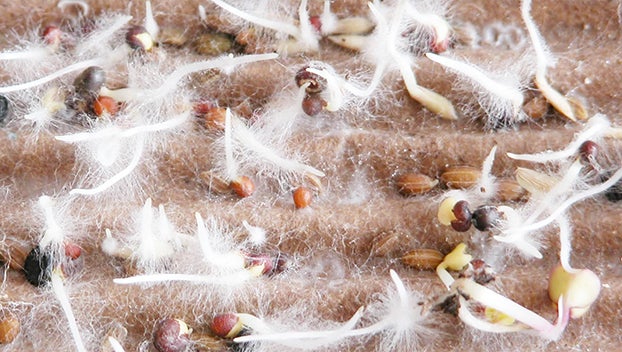MASTER GARDENER — Developing roots is important with mycorrhizae
Published 12:16 am Wednesday, July 19, 2023

- Seeds germinating in mycorrhizae-rich environments demonstrate hyphae, which are long, thread-like branching structures that are tiny filament highways that absorb surrounding nutrients, allowing them to be transported throughout the thallus or fungus body. (fungi.com)
|
Getting your Trinity Audio player ready...
|
Let me start by saying, Wow! It’s amazing how many emailed responses I received from around the country regarding last week’s gardening topic. Fortunately, most of you were kind, informing me of a mistake.
The embedded image was of an Eastern Swallowtail rather than a Monarch butterfly, and I apologize for the error.
What are Mycorrhizae (pronounced mi-cor-rhi-za)?
Literally translated, mycorrhizae mean fungus root, which are fungi that grow in association with a plants root system where a symbiotic relationship is developed between the two.
The fungi colonize the root system of a plant, providing increased water and nutrient absorption capabilities while the plant provides the fungi with carbohydrates “sugar” created from photosynthesis.
Another added benefit of the symbiosis: mycorrhizae offer the plant increased protection against numerous pathogens.
Approximately 95 percent of all land plants live in association with mycorrhizal fungi. These fungi encompass numerous groups within the fungi Kingdom, which are divided into two related groups: ectotrophic and endotrophic, which are based upon the position of the fungal hyphae and relation to plant root tissue (cells).
What exactly are hyphae (hy-pha)?
Long, thread-like branching structures (tiny filament ‘highways’) that absorb surrounding nutrients, allowing them to be transported throughout the fungus body (thallus). Ectomycorrhizal fungi cover the root cells, without penetrating the roots. Conversely, endomycorrhizal fungi penetrate and enter plant root cells.
Gardeners, some of you may never have heard the term mycorrhizae before today. These fungi are necessary, living and growing on plant roots, with most all plants having some form of mycorrhizae growing on them, which have become an extension of their root system.
These fungi are found growing on vegetables, flowers, bulbs, trees, and shrubs. Mycorrhizae help the plant absorb and hold both major and minor nutrients, increase the plants tolerance to stress and drought, while inhibiting disease and other pathogens in the soil.
The key takeaway about the symbiotic relationship between mycorrhizae and plants’ center on the plant’s ability to produce carbohydrates through photosynthesis and sharing energy (sugar) with fungi, in return for water and nutrients sourced from the soil.
Benefits of Mycorrhizae:
Root System Growth
- Mycorrhizae fungi supports faster plant establishment.
- Allows water and nutrients access beyond the root zone and deliver them to the plants vascular system.
- Increases absorption area by as much as 50 percent
- Increases overall root biomass.
Nutrient Efficiency
- Absorb and deliver nutrients directly to the roots.
- Improves nutrient utilization including nitrogen, phosphorus, potassium, plus all micronutrients.
Water Absorption
- Absorb and transport moisture from beyond the root zone to the plant’s roots.
- Increases water utilization capability by the plant, improving stress tolerance by increased drought resistance.
Speaking of mycorrhizal fungi, there are two types: Endomycorrhizal and Ectomycorrhizal.
Endomycorrhizal fungi form a relationship with about 90 – 95 percent of the plant families. These fungi penetrate the root cortex (cells) creating a nutrient exchange structure (highway) within the root cells.
Ectomycorrhizal fungi form a relationship with up to 10 percent of the plant families. These fungi mainly pair with conifer and hardwood trees. They do not penetrate the root cell walls but form a sheath around the root, creating nutrient exchange structure known as a “Hartig net”.
As always, I recommend taking soil samples from each gardening area and submitting them for detailed analysis. Contact your local county extension office for more details and where to submit samples for analysis.
The analysis cost is minimal, typically less than $20, but the report and information provided (usually within 2 weeks) are invaluable! Utilize the information in the report to amend the soil and note the reports phosphorus level, since high phosphorus in the soil will inhibit mycorrhizae formation, which means purchasing mycorrhizae and adding it to the soil will be a waste of money.
Further note, mycorrhizae are inhibited by chemical fertilizers but not organic fertilizers. Utilize well-decomposed compost, but not fresh compost as it will also inhibit the fungi growth.
It is important when using mycorrhizal fungi in your garden, to make certain the correct fungi form for the plants you are working with, so READ THE LABEL.
As an example, I have two containers of Mycorrhizal, one is only Endomycorrhizal fungi, while the other has four-strains of Endomycorrhizal fungi and seven-strains of Ectomycorrhizal fungi. My point being the container with both fungi forms wouldn’t be used on vegetables and flowers, but would be used on trees, shrubs, and woody ornamentals.
The next time you’re out and about, buy some mycorrhizae for your plants, as they are going to love that you did!
So long for now fellow gardeners, let’s go out and grow ourselves a greener, more sustainable world, one plant at a time!
Thank you for the comments and questions (please be kind).
John Green is Texas Certified Master Gardener. If you have gardening questions, email jongreene57@gmail.com.





